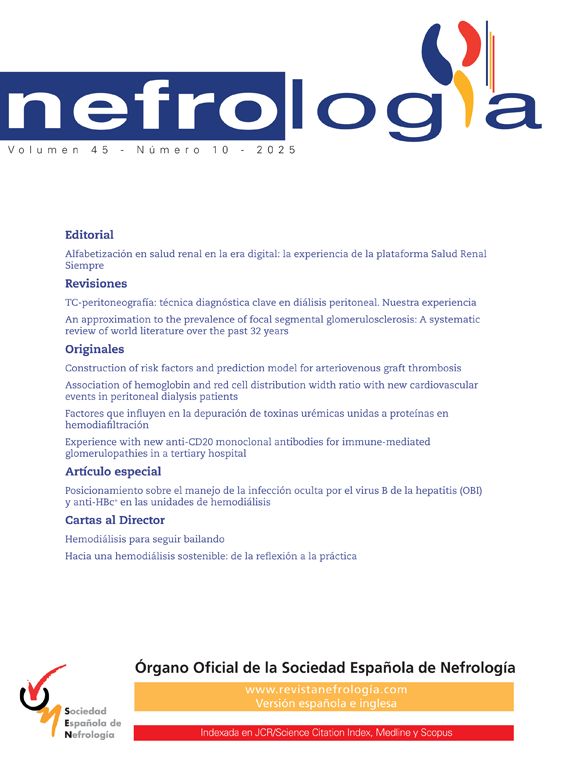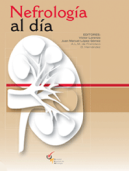Irisin, a myokine generated through the proteolytic cleavage of fibronectin type III domain-containing protein 5 (FNDC5), has been increasingly recognized as a critical mediator of the salutary effects of physical exercise on metabolic homeostasis, energy metabolism, and the regulation of inflammatory, oxidative, and fibrotic pathways. Recent investigations have delineated a significant association between irisin levels and renal pathophysiology, particularly within the context of chronic kidney disease. Emerging evidence suggests that irisin may play a modulatory role in renal function, with particular relevance to diabetic nephropathy and acute kidney injury. Therefore, this mini-review consolidates current findings on the mechanistic underpinnings of irisin's involvement in renal pathophysiology, elucidating its intricate interplay with kidney disease. Additionally, we highlight the potential of irisin as a promising biomarker and therapeutic target in nephrology.
La irisina, una mioquina generada mediante escisión proteolítica de la proteína fibronectina de tipo III que contiene el dominio 5 (FNDC5), ha sido cada vez más reconocida como mediador esencial de los efectos saludables del ejercicio físico en la homeostasis metabólica, el metabolismo energético y la regulación de las vías inflamatoria, oxidativa y fibrótica. Las investigaciones recientes han delineado una asociación significativa entre los niveles de irisina y la patofisiología renal, en particular dentro del contexto de la enfermedad renal crónica. La evidencia emergente sugiere que la irisina puede jugar un papel modulador en la función renal, con relevancia particular para la nefropatía diabética y el daño renal agudo. Por tanto, esta mini-revisión consolida los hallazgos actuales sobre los fundamentos mecánicos de la implicación de la irisina en la patofisiología renal, esclareciendo su interacción intricada con la enfermedad renal. Además, subrayamos el potencial de la irisina como biomarcador prometedor y objetivo terapéutico en nefrología.
Chronic kidney disease (CKD) is a global health burden, affecting approximately 10% of the world's population and contributing significantly to morbidity and mortality. The CKD is characterized by a gradual decline in renal function and an increased risk of cardiovascular complications. Despite advances in treatment, the progression of CKD remains a major clinical challenge, necessitating the exploration of novel therapeutic targets.1
Irisin, a myokine predominantly secreted by skeletal muscles during physical activity, was first identified in 2012 and has garnered attention for its pleiotropic effects on metabolism, inflammation, and tissue repair.2 Emerging evidence suggests that irisin may play a protective role in kidney disease, offering new insights into the interplay between muscle and kidney health.3 Hence, Irisin could contribute to the identification of novel biomarkers and therapeutic agents for early detection and intervention in CKD. Here we will clarify some aspects involved with Irisin and renal diseases and highlight its potential contribution as biomarker or therapeutic target in renal pathophysiology.
Irisin: biosynthesis and physiological functionsIrisin is predominantly synthesized by skeletal muscle in response to physical activity, with its expression regulated by peroxisome proliferator-activated receptor gamma coactivator 1-alpha (PGC-1α), a key transcriptional coactivator that modulates multiple nuclear receptors and transcription factors.4 Identified as a proteolytic derivative of fibronectin type III domain-containing protein 5 (FNDC5), irisin is secreted into the circulation, where it exerts systemic metabolic effects.4
Initially characterized for its role in inducing the browning of white adipose tissue and enhancing thermogenesis, irisin has since been implicated in a broad spectrum of physiological processes, including the enhancement of insulin sensitivity, the regulation of glucose metabolism, the maintenance of energy homeostasis, and the modulation of lipid profiles.4,5 Beyond its metabolic functions, irisin exhibits potent anti-inflammatory and antioxidant properties, which are of particular relevance to renal pathophysiology. Its expression is dynamically influenced by various factors, including physical activity, metabolic status, and inflammatory conditions.3,5
Irisin and chronic kidney diseaseRecent investigation has established a significant association between circulating irisin levels and chronic kidney disease (CKD).6,7 A comprehensive systematic review and meta-analysis of multiple observational studies demonstrated that patients with CKD exhibit significantly reduced serum irisin concentrations compared to non-CKD individuals. This decline in irisin levels correlates with the severity of renal dysfunction, as evidenced by an inverse relationship between irisin and key renal function biomarkers, such as urea and creatinine, thereby suggesting its potential utility as a biomarker for CKD progression.7 Moreover, clinical data have further corroborated these findings, indicating that irisin concentrations are particularly diminished in CKD patients undergoing dialysis.7,8
The mechanisms contributing to the decreased irisin levels in CKD appear to be multifactorial. One prevailing hypothesis suggests that uremic toxins, such as indoxyl sulfate, may exert direct inhibitory effects on FNDC5 expression in myocytes, thereby attenuating irisin secretion. Experimental evidence supports this proposition, as studies involving human immortalized myoblast cells exposed to indoxyl sulfate have demonstrated a dose-dependent reduction in FNDC5 protein levels, implicating that uremic milieu acts as a key factor in the dysregulation of irisin production.8
Irisin's protective effects on renal pathophysiologyTherapeutic potential of irisinIrisin has exhibited significant therapeutic potential in experimental models of renal injury. In a murine model of renal ischemia–reperfusion injury (IRI), the administration of recombinant irisin markedly mitigated kidney dysfunction, tissue damage, tubular cell apoptosis, and inflammation, highlighting its protective effects in acute renal injury.9 Additional evidence supports the renoprotective role of irisin in acute kidney injury (AKI), as demonstrated in murine sepsis models, where irisin administration alleviated sepsis-associated AKI by modulating the SIRT1/Nrf2 pathway and reducing ferroptosis.10 Moreover, irisin has been implicated in the restoration of autophagic processes in podocytes, a critical mechanism for safeguarding against diabetic nephropathy.11
These findings collectively suggest that irisin represents a promising candidate for the development of novel therapeutic strategies targeting kidney diseases. However, the precise molecular mechanisms underlying its nephroprotective effects remain to be fully elucidated. Thus, review aims to synthesize current evidence on the potential mechanisms through which irisin exerts its renoprotective actions while also highlighting key clinical observations.
Mechanisms of Irisin protection in kidney disease- i.
Anti-inflammatory effects
Inflammation is a fundamental pathological feature of chronic kidney disease (CKD) and plays a pivotal role in its progression toward renal failure. Irisin has been shown to exert anti-inflammatory effects by suppressing the production of pro-inflammatory cytokines, including tumor necrosis factor-alpha (TNF-α), interleukin-6 (IL-6), and interleukin-1 beta (IL-1β), through the downregulation of nuclear factor kappa B (NF-κB) signaling. A study demonstrated that lipopolysaccharide (LPS) stimulation significantly increased the expression levels of TNF-α, IL-1β, Bax, p65, and IκKα while concomitantly inhibited Bcl-2 and IκB-α expression in renal tubular cells. Notably, irisin administration to renal cells cultures effectively reversed these inflammatory alterations.12
Furthermore, in an in vivo model of diabetic nephropathy, it was observed that FNDC5/irisin expression was upregulated in renal tissue following exercise training. Compared to sedentary controls, exercise-induced irisin enhanced an anti-inflammatory cytokine profile and promoted M2 macrophage polarization (CD206 expression) within kidney tissue via activation of the AMP-activated protein kinase (AMPK).13 Other study reported that Irisin alleviates inflammation in IRI mice model via modulating the PI3K/Akt/eNOS and TLR4-NFkB pathways. Relative to control, the gene expressions of PI3K, AKT and TLR-4 were elevated in IRI group, however, Irisin treatments restored renal function and inhibited all these inflammatory markers in renal tissues.14 These findings suggest that irisin may mitigate renal inflammation through modulation of the NF-κB/TLR-4/PI3K/AKT/AMPK signaling pathways, highlighting its potential as a therapeutic agent in CKD-associated inflammation.
- ii.
Antioxidant properties
Oxidative stress is a key pathological driver in the progression of kidney disease and has been a primary target for various pharmacological interventions. Irisin has been shown to enhance mitochondrial function and mitigate the production of reactive oxygen species (ROS).15 Experimental evidence demonstrates that irisin administration alleviates renal injury by attenuating inflammatory responses, improving mitochondrial function, specifically through the upregulation of uncoupling protein (UCP) and mitochondrial transcription factor A (Tfam) and reducing endoplasmic reticulum stress markers, including GRP78, phosphorylated inositol-requiring enzyme 1-alpha (p-IRE1α), phosphorylated eukaryotic initiation factor 2-alpha (p-eIF-2α), C/EBP homologous protein (CHOP), and endoplasmic reticulum oxidoreductin 1-like protein alpha (Ero1-Lα) following IRI induction.15
Additionally, it was reported that irisin administration preserves renal superoxide dismutase (SOD) and glutathione peroxidase (GSH-Px) levels and effectively suppressed ROS accumulation (DHE staining) after IRI.16 Mechanistically, irisin is proposed to attenuate AKI-associated oxidative stress by upregulating phospholipid peroxidase glutathione peroxidase 4 (GPX4), a critical regulator of lipid ROS homeostasis and ferroptosis, thereby exerting renoprotective effects.16
- iii.
Antifibrotic actions
Renal fibrosis is an irreversible common endpoint in progressive kidney diseases and has been considered the bet biomarker for bad prognosis. In unilateral ureteral obstruction (UUO) mice, it was identified that irisin ameliorated renal function decreasing the expression of periostin and MMP-2, attenuated epithelial-mesenchymal transition (EMT) and extracellular matrix deposition in renal tissues.17 In HK-2 cells, irisin treatment markedly attenuated TGF-β1-induced expression of periostin and MMP-2.17 Irisin treatment also inhibited TGF-β1-induced EMT, extracellular matrix formation, and inflammatory responses.17In vitro also was showed that Irisin inhibited TGFβ-induced COL1 in renal cells, which was not affected by conditioned medium of muscle cells transfected with FNDC5 siRNA.18 Summary, irisin treatment can improve renal interstitial fibrosis through the TGF-β1/MMP-2 signaling pathway modulation, suggesting that irisin may has an important role in the context of kidney fibrosis.
- iv.
Modulation of apoptosis
Apoptosis is a hallmark of acute kidney injury (AKI), contributing to the loss of renal tubular epithelial cells, which are highly susceptible to damage in both AKI and CKD. Emerging evidence suggests that irisin exerts potent anti-apoptotic effects in renal tubular cells. In kidney tissues subjected to IRI, irisin was shown to activate the phosphoinositide 3-kinase (PI3K)/Akt signaling pathway, thereby promoting cell survival and attenuating apoptosis by downregulating caspase-3 expression while upregulating B-cell lymphoma 2 (BCL2) levels.14
Additionally, irisin overexpression has been demonstrated to mitigate apoptosis in lipopolysaccharide (LPS)-induced renal injury, as evidenced by reduced annexin V staining in tubular cells.19 In an animal model of IRI, irisin pretreatment was found to upregulate the expression of uncoupling protein 2 (UCP2), conferring protection against renal cell apoptosis characterized by decreased TUNEL and caspase-3 staining and oxidative stress as indicated by reduced myeloperoxidase (MPO) and malondialdehyde (MDA) levels which were both mediated by AMP-activated protein kinase (AMPK) activation. In vitro, hypoxia/reoxygenation (H/R) treatment was employed to induce apoptosis in tubular cells, and irisin pretreatment significantly attenuated the apoptotic response.15 Moreover, the irisin overexpression or supplementation with recombinant irisin was shown to alleviate ATP depletion-induced apoptosis.15,19 Thus, mechanistically, irisin was found to suppress the activation of p53 and PI3K/AKT/AMPK signaling pathways, using both in vivo and in vitro models of kidney injury, highlighting its role as a critical modulator of renal cell survival and a potential therapeutic target in nephroprotection.
Irisin participation in clinical perspectivesThe pleiotropic effects of irisin make it a promising candidate for the treatment of kidney disease. Preclinical studies have already demonstrated that irisin administration improves renal function, reduces proteinuria, and attenuates histopathological damage in animal models of CKD and AKI.9–19 Furthermore, irisin levels have been proposed as a potential biomarker for early detection of kidney injury, as lower circulating irisin levels are associated with worse renal outcomes in patients with CKD.20
Beyond its role as a biomarker, irisin may exert renoprotective effects through its anti-inflammatory, antioxidative, and anti-apoptotic properties. These actions are particularly pertinent in mitigating the pathogenesis of AKI/CKD and its associated complications, such as protein-energy wasting, cardiovascular disease, diabetes and mineral bone disorders.21 In addition, considering exercise and metabolic context, irisin administration could potentially improve kidney function and prevent disease progression by modulating inflammation, fibrosis, cell death and oxidative stress.22
Moreover, osteoporosis and reduced bone mineral density are prevalent among CKD patients, contributing to increased fracture risk and morbidity.7 Recent investigations have explored the relationship between serum irisin levels and bone health in this population. Cross-sectional study involving hemodialysis patients and renal transplant recipients found a positive correlation between serum irisin concentrations and femoral T-scores (values of bone mineral density), suggesting a potential role for irisin in bone metabolism and its possible utility as a therapeutic target for CKD-related bone disorders.23
Finally, in patients with type 2 diabetes, impaired renal function is associated with a reduction in irisin levels. The authors have shown that irisin correlates with estimated glomerular filtration rate (eGFR) and body composition, suggesting that irisin be associated with renal function in diabetes.24
Given these findings, a multicenter prospective observational cohort study focused on biomarker validation is warranted. The primary aim of this investigation would be to ascertain whether baseline and serial measurements of circulating irisin predict the trajectory of renal function decline and the incidence of definitive renal endpoints (e.g., a ≥30% reduction in eGFR or the initiation of renal replacement therapy). Specifically, this study would: (i) determine whether low baseline irisin concentrations, or a progressive decline over time, serve as independent predictors of accelerated CKD progression; (ii) define the optimal irisin threshold values for stratifying patient risk; and (iii) generate the foundational data required to integrate irisin into clinical risk-prediction algorithms.
In parallel, an embedded, randomized, biomarker-guided management trial should also be considered to evaluate whether therapeutic modifications informed by irisin measurements (for instance, intensification of antihypertensive, glycemic or mineral bone management in individuals exhibiting “high-risk” irisin profiles) translate into improved renal outcomes. Additionally, given that physical activity is a potent endogenous stimulus for irisin release, and has been associated with favorable effects on inflammation, oxidative stress, and muscle wasting in CKD, a physical exercise intervention arm could be incorporated to explore whether moderate, structured exercise increases circulating irisin levels and subsequently mitigates renal function decline. This trial would compare eGFR slopes between intervention and control arms via mixed effects modeling, assess the effect of biomarker-driven strategies on hard clinical endpoints, and concomitantly evaluate the safety and feasibility of implementing irisin-based clinical algorithms.
Together, these two-stage clinical approaches would meet the essential criteria for biomarker qualification, demonstrating that irisin adds prognostic value beyond established risk factors, and it would subsequently establish clinical utility by confirming that irisin-guided interventions, including lifestyle-based approaches, can meaningfully alter patient trajectories. Such evidence would underpin regulatory approval and facilitate the incorporation of irisin as a novel biomarker in the management of chronic kidney diseases.
Challenges and future directionsDespite promising outcomes, several challenges related to irisin's biodistribution and biosafety remain unresolved. Although not specifically investigated in the context of kidney disease, one study reported that excessive irisin exposure induced oxidative stress and apoptosis in murine cardiac tissue, raising concerns about its potential deleterious effects under certain conditions.25 This highlights the complexity of irisin's pleiotropic systemic effects, which may vary depending on the physiological and pathological context, necessitating further in-depth investigation particularly in conditions where multiple signaling pathways with distinct and potentially opposing roles are involved.
Moreover, the precise molecular mechanisms underlying irisin's renal effects remain incompletely understood. Additional mechanistic studies, along with well-designed, large-scale clinical trials, are essential to substantiate its therapeutic potential in nephrology. Furthermore, the development of irisin-based therapeutic strategies requires careful optimization of dosage, targeted delivery methods, and comprehensive safety evaluations to mitigate potential adverse effects and maximize clinical efficacy.
ConclusionAccumulating evidence indicates that irisin serves as a critical link between skeletal muscle activity and renal health. Consequently, irisin has emerged as a pivotal modulator in the pathophysiology of kidney disease, with significant implications for both the prevention and treatment of renal disorders. Its potent anti-inflammatory, antioxidant, and antifibrotic properties highlight its potential as a promising therapeutic agent. Furthermore, the observed inverse correlation between circulating irisin levels and different stages of kidney disease supports its candidacy as a potential biomarker for renal dysfunction.
However, despite these promising findings, further investigations are necessary to delineate the precise molecular and cellular mechanisms underlying irisin's renoprotective effects, assess potential adverse effects, and bridge the gap between preclinical discoveries and clinical applications. Rigorous translational research and well-designed clinical trials will be essential to validate its therapeutic utility in clinical nephrology.
Conflict of interestThe authors declare no conflict of interest.
We would like to express our gratitude to the Coordenação de Aperfeiçoamento de Pessoal de Nível Superior (CAPES) and the Conselho Nacional de Desenvolvimento Científico e Tecnológico (CNPq) for their continuous academic and research support.






